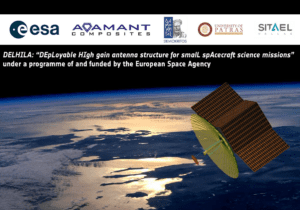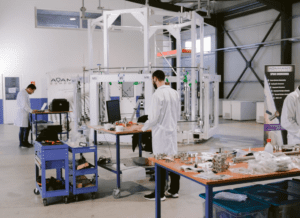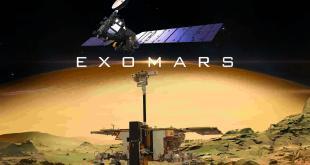
A flagship ESA project has just landed in Greece! Being kicked off amidst the coronavirus crisis and the consequent financial uncertainty, ESA has entrusted the Greek consortium led by Adamant Composites to develop a deployable structure that can work as an antenna for small satellites. The activity was kicked-off via teleconference on the 2nd June 2020.
The DELHILA project (DEpLoyable HIgh gain antenna structure for smalL spAcecraft science mission, pronounced Delilah) puts Greece on the global map of Deployable Structures technologies, being the second activity to arrive after LAGARD (Large stable deployable structures). Deployable structures are crucial for space missions as they save tremendous amounts of volume in the launch configuration, while allowing large structures to be formed in space. They have been identified as a critical technology for Europe’s non-dependence in the Global Space Market. The project covers all the steps of development: design, breadboarding, manufacturing, assembly, integration and testing to flight readiness.
Adamant Composites, with a demonstrated record on challenging projects, is the Prime contractor of the activity and has partnered with a team of recognized Greek entities bringing long experience in space engineering studies to develop a competitive subsystem and test it up to flight readiness. For the implementation of the work, Adamant Composites will work closely with NCSR-Demokritos (WiCom lab for RF design), University of Patras (Applied Mechanics Laboratory with expertise in space missions and systems), and SITAEL Hellas (Greek subsidiary of SITAEL; recognized Italian system integrator with a focus on small satellites).
The reflector will have a deployed diameter of 1.5-2.0m and shall fit in a cylinder of 0.2m diameter and 1.0m length inside a small satellite platform. The antenna to be supported will be a high gain antenna operating at X-band with a 2 GHz bandwidth. The total mass of the deployable system is expected to be below 10kg. Product specifications will be consolidated during the work and will be aligned with the needs in NewSpace and the emerging market of Small satellites. The project will run in phases; Phase 1 will cover the design and critical Breadboarding until the Preliminary Design Review, while Phase 2 will cover the Detailed Design and all Manufacturing, Assembly, Integration and Testing to bring the system to TRL7.
The DELHILA project comes shortly after the bold move by the Greek Ministry of Digital Governance and the Secretariat General of Telecommunications and Post to increase the subscription to ESA for space technology developments and in anticipation of the Greek Earth Observation Micro-Satellite programme. This project is a “vote of confidence” to the human capital and the strong industrial capabilities established at certain Greek companies for developing and integrating subsystems for micro-satellites.
Dr. Antonios Vavouliotis, Managing Director of ADAMANT COMPOSITES comments on the kick-off of the project: “DELHILA for us is a product-oriented development activity that brings together trusted partners of the Greek Space ecosystem with long term investments in upstream space technologies. We are excited to continue the deployable structures endeavor, contributing to strengthen Greece’s presence in the Space market and attempting to capture the potential created by the end application of such complex systems; in science, telecommunications, earth observation”

Dr. Dimitris Vlachos, Technical Director and Project Manager of ESA-DELHILA adds: “The progress of the LAGARD project; among the largest ESA technology development project awarded to Greece until now; has confirmed that Adamant Composites is able to handle even greater challenges and deliver important results. DELHILA brings us one step closer to accomplishing the goal of introducing a Greek high technology product to the global Space market.” Dr. Antonis Alexandridis, Head of WiCom Lab/NCSR Demokritos continues: “The ESA-DELHILA project is a great challenge for our Laboratory, as we have the chance to exploit in the field of Space Applications our infrastructure, expertise and know-how in antenna technologies. We believe that this project will be a pilot for the expansion of our research collaborations with the European Space Agency as well as with high-tech Greek companies such as Adamant Composites.”
Prof. Vassilis Kostopoulos, Director of Applied Mechanics Laboratory/University of Patras adds: “DELHILA is an exemplary cooperation between the Research community and the Space Industry for Greece, while a unique opportunity to train hands-on the next generation of Greek Space engineers. We are very happy for the kick-off of this activity where we can contribute our long experience and know-how in space missions and engineering.” Mr. Nikolaos Bazakas, Managing Director of SITAEL Hellas comments: “In these very challenging times it is even a bigger success to start this important activity and SITAEL Hellas is proud to bring to the team the satellite system expertise in the development of such a strategic product for both Greece and Europe. In the journey to develop the Greek Space ecosystem another step was taken with today’s signature.”
DISCLAIMER: The views expressed herein can in no way be taken to reflect the official opinion of the European Space Agency.
This announcement was made on 22 June 2020 by Adamant Composites.





